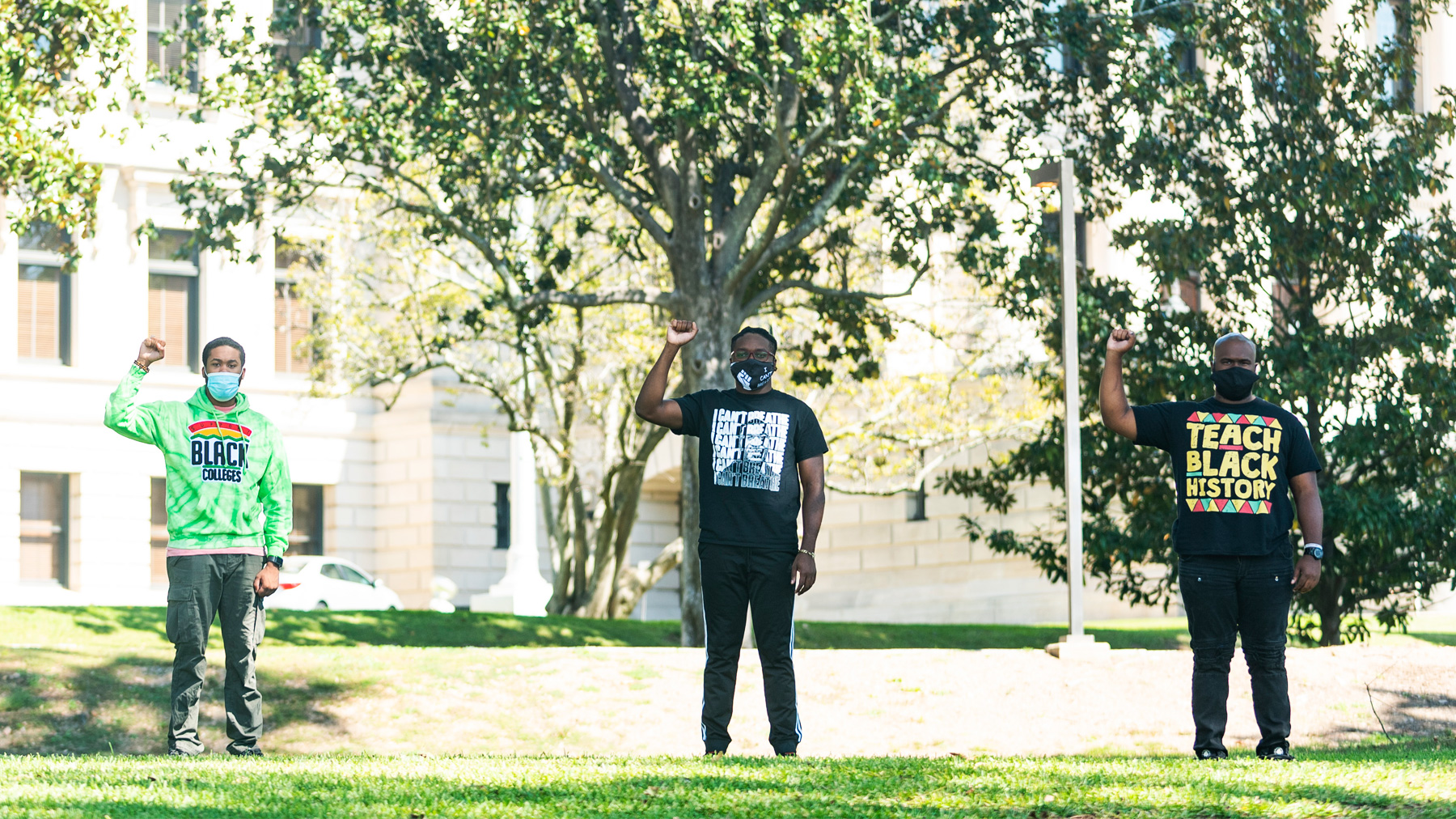On the day of the demonstration, Jarrius Adams stood in front of the Mississippi Governor’s Mansion in Jackson, where the state flag bearing an image of the “rebel flag” of the Confederacy flew to his left. Scores of people lined the street, eager to hear Adams speak as they marched elbow to elbow in solidarity for Black lives. Drones circled overhead, and supporters held signs, one reading “Racism is a Virus.” The demonstration would be called one of the largest in Mississippi’s history. Its success would bring historic change that had long eluded civil rights activists.
For decades, Black people in Mississippi had been trying to persuade state leaders to furl the state flag once and for all. Adams and fellow activists from Black Lives Matter (BLM) Mississippi – Taylor Turnage, Timothy Young and Calvert White – had decided it was their turn to carry the work forward in the wake of George Floyd’s violent death at the hands of Minneapolis police in May.
On June 6 at promptly 3 p.m., the activists presented a list of demands for the state to consider, including that Mississippi change the state flag that had borne the Confederate emblem since 1894, a painful reminder of the state’s role in the fight to maintain the enslavement of Black people during the Civil War and white supremacy that continues to this day.
Their speeches emboldened the crowd. Applause and chants of “Take it down!” echoed throughout the street. To honor Floyd and affirm the fight for racial justice, some demonstrators carried posters reading, “I Can’t Breathe” – Floyd’s final words.
In the following weeks, the BLM activists continued to build momentum, working tirelessly to create a broad coalition to support the movement.
The effort paid off: On June 28, lawmakers passed House Bill 1796, mandating the removal of the state flag and establishing a commission to recommend a new design to voters – a design that could not contain an image of the Confederate battle flag. Mississippi Gov. Tate Reeves signed the bill into law two days later.
“I had no words,” said Adams, who organized the demonstration and works as a voter protection organizer for the Mississippi Democratic Party. “We were finally seeing the fruits of our ancestors’ labor. But I wish this would’ve happened 20 years ago or more.”
On Nov. 3, Mississippi voters overwhelmingly approved a new flag featuring a magnolia, the state flower, at its center.
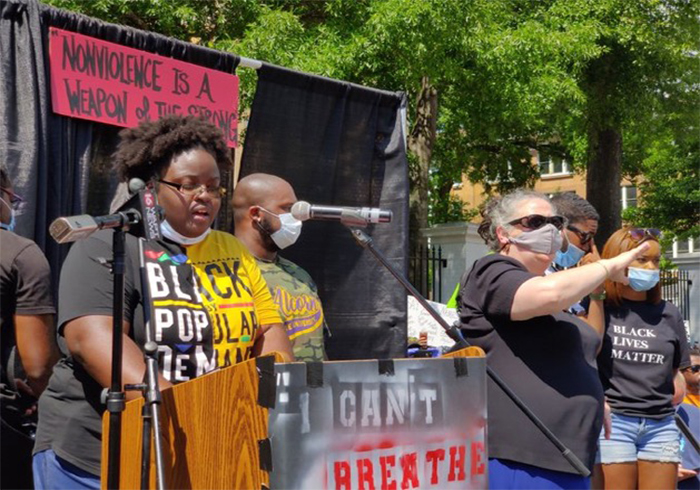
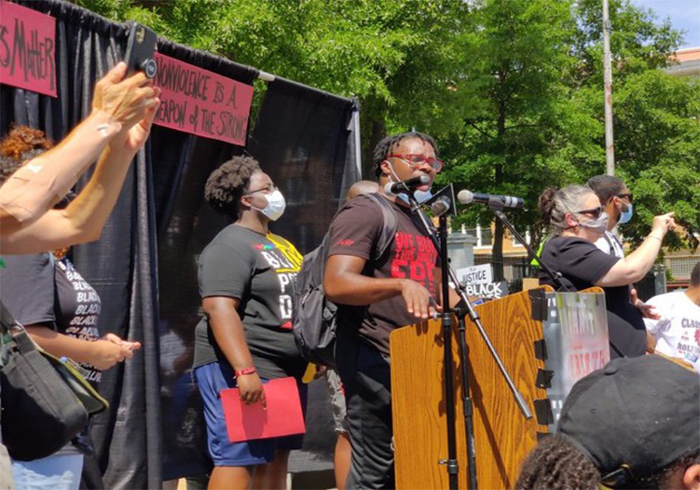
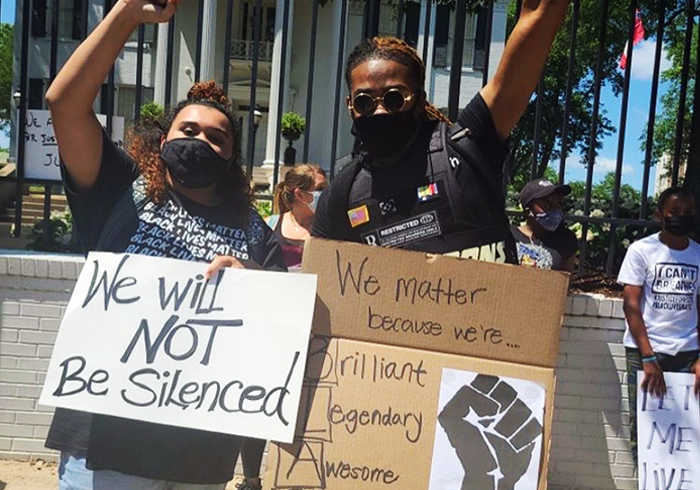
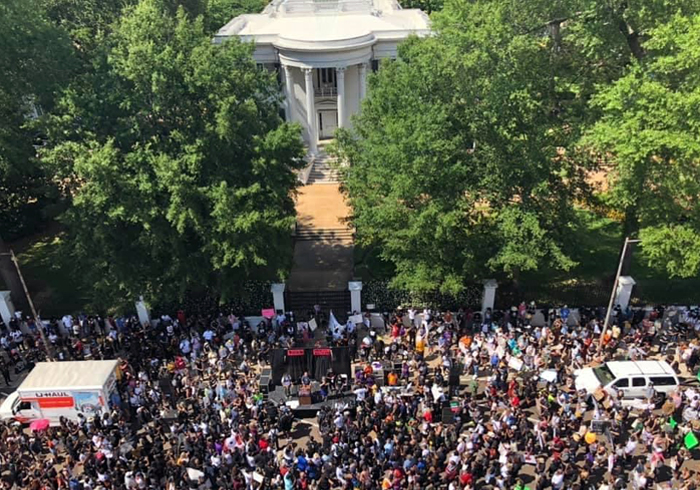
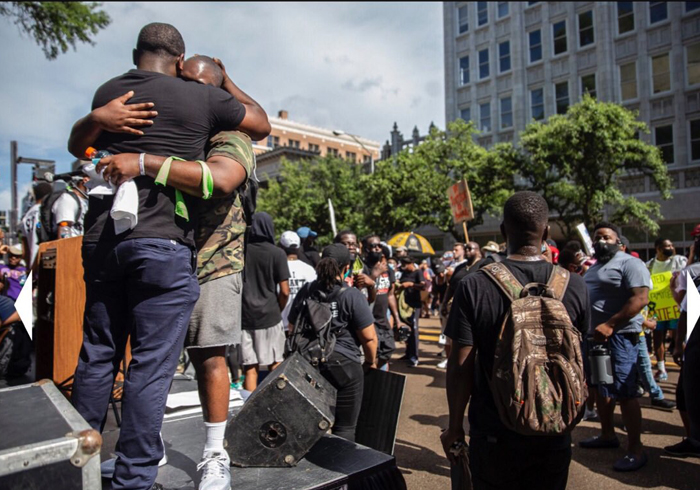
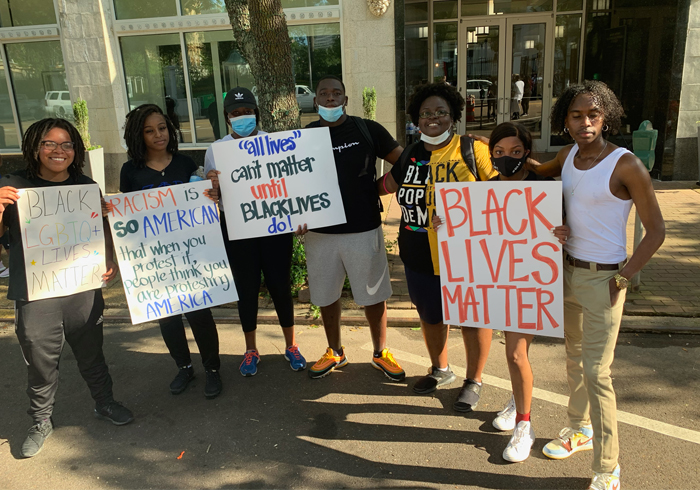
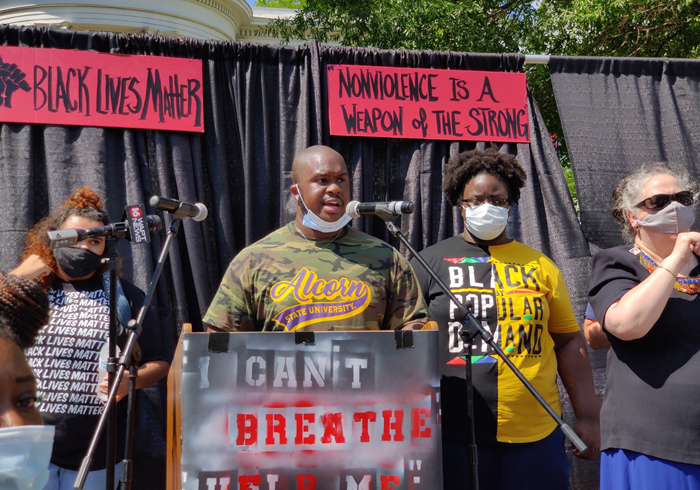
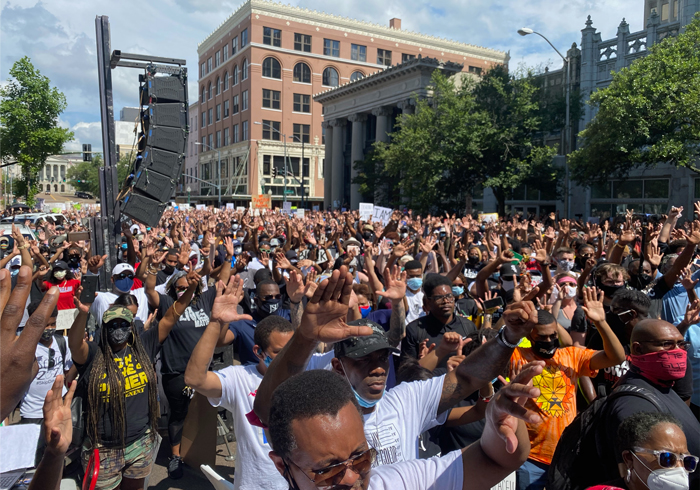
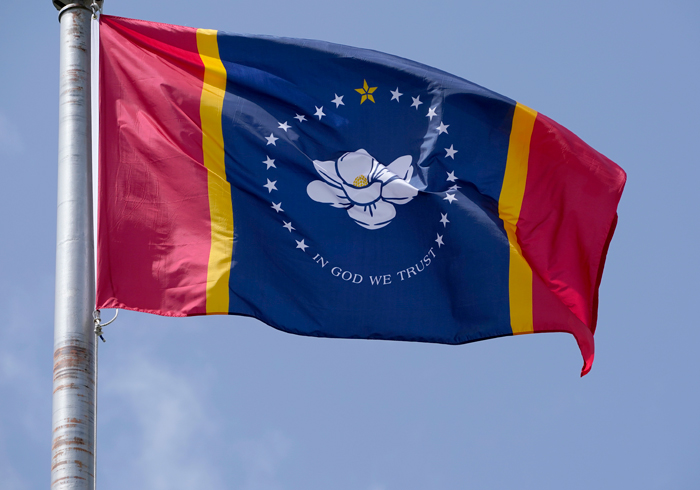
A tipping point
Mississippi adopted its Confederate-themed state flag at the beginning of Jim Crow segregation, just four years after enacting a new constitution designed explicitly to enforce white supremacy and keep political power out of the hands of Black people, in part by requiring literacy tests and poll taxes for voting. This system of oppression was also kept intact by widespread terror lynchings.
Over the next 30 years, hundreds of Confederate monuments, memorials and flags were installed throughout the South, often at courthouses and town squares. The Southern Poverty Law Center (SPLC), in its 2016 report Whose Heritage?, found that the vast majority of the nearly 1,800 such symbols on public property were put into place during two distinct periods – first, from the mid-1890s to 1920 (the beginning of Jim Crow segregation) and later, during the 1950s and 1960s, as Southern states fought back against the civil rights movement.
Gov. George Wallace, for example, raised the Confederate flag over Alabama’s state Capitol in April 1963 in an act of defiance on the eve of a visit by U.S. Attorney General Robert F. Kennedy to discuss desegregation and voting rights. It flew there until 1993.
But a tipping point in the fight over Confederate iconography came on June 17, 2015, when a white supremacist killed nine Black worshippers at the iconic “Mother Emanuel” AME Church in Charleston, South Carolina. Photos later surfaced on social media showing the attacker with the Confederate battle flag – including an image in which he held the flag in one hand and a gun in the other.
The premeditated murders shocked the nation and ignited a powerful grassroots movement to remove Confederate imagery from public spaces. South Carolina swiftly relocated a Confederate flag that had flown at its Statehouse for 54 years. Officials in New Orleans voted to remove prominent statues. Within a year, more than 100 such symbols across the nation had been removed, renamed or relocated.
And then came the death of George Floyd. By Oct. 16, the SPLC had documented the removal of another 102 monuments, place names and other symbols.
Seizing the moment
In Mississippi, the flag had already survived prior removal attempts, including in April 2001, when the state voted overwhelmingly along race lines to retain it. After the Charleston massacre, citizens again urged the removal of the Confederate symbol from the state flag, but that movement also failed.
This was, after all, a place where racism had been “built into the very bones” of the state, wrote novelist Jesmyn Ward in The Atlantic. It’s a place where many people had been killed simply for trying to gain access to the ballot box – a place where, during Freedom Summer in 1964, three young activists were murdered by the Klan for trying to register Black people to vote.
But despite the state’s fierce resistance to change, the activists in Mississippi were hopeful, and determined.
Throughout June, they gained support from groups like the Mississippi NAACP and One Voice. They conducted phone banks to encourage people to contact their elected officials and mobilized volunteers through social media. They spent late nights strategizing.
“We went to the state Capitol several times, explaining why now is the time,” Adams, 23, said. “We made flyers and partnered with leaders to organize folks to make calls to their mayor or city council people, and to put pressure on those they knew at the state Capitol. We couldn’t wait and let this pass; we had to act fast.”
Although their hard work paid off, the public debate was “as divisive as the flag itself,” said Reeves, the governor. As the decision to remove the flag rested in the hands of the Legislature, economic pressure arrived from outside the state. The National Collegiate Athletic Association warned that it would no longer hold major competitions there unless the flag came down. The organization’s Southeastern Conference also weighed in, telling lawmakers the state could miss out on conference championship games.
When the decision was final, co-organizer Calvert White said that many white Mississippians felt “attacked” because “their history was erased.” To that, White argued that they try to understand what it’s like as a Black person living in a state whose flag memorializes white supremacy and slavery.
“Imagine how we’ve felt all these years,” White, 20, said. “There are so many places we go in Mississippi where we don’t feel safe. The Confederate flag is a large reason for that.”
As for why he and the others were the ones to create the change that seemed so long out of reach, White said the group was simply at the right place during the right moment in history.
“We always acknowledge that it could’ve been anybody in our shoes,” said White, an English major at Alcorn State University. “But it happened to be us on the stage. We were able to make our voices heard, and others can do the same.”
Tired of being silent
The idea for the demonstration began through a BLM Mississippi group chat, where the activists decided it was no longer enough to sit idly by and speak to each other about social injustices. As they began discussing a rally, they didn’t know each other personally; they were only connected online, along with hundreds of other BLM Mississippi members.
When they met, they found they had mutual friends; they shared the same goals, the same mindset, the same interests and a shared vision for the demonstration and what it could potentially bring. It was time for them to demand action.
“Nothing will get changed unless you go out there and show the state officials that people in the state actually want change,” said co-organizer Taylor Turnage, 24. “We were tired of being silent.”
The flag was the first domino to fall. Others soon followed.
By July 9, Mississippi’s Bolivar, Leflore, Lowndes, Noxubee and Washington counties had decided to move monuments dedicated to the Confederacy away from courthouses. On July 14, the University of Mississippi – known as “Ole Miss” and the scene of deadly mob violence over desegregation in 1962 – removed a marble statue of a Confederate soldier from a prominent spot on its Oxford campus. On July 18, McComb’s city board voted for the downtown bridge to be renamed Black Lives Matter. And on Sept. 24, the Jackson Public Schools district began seeking community response to rename a majority-Black school named after Confederate General Robert E. Lee.
Adams likened this rapid change to “the closing of a chapter.”
“Mississippi really has something to say,” he said. “I think this is an awesome statement to the people of ‘old’ Mississippi that [white supremacy] will not fly any longer.”
‘A new dawn’
Once the vote to remove the state flag became official, many lawmakers teared up as a chorus of praise rippled through the halls of the state Capitol. The flag was removed for the last time on July 1, and then, after an official ceremony, it was sent to a history museum.
Co-organizer Timothy Young – a 2019 graduate of Jackson State University who spent weeks encouraging people to attend the demonstration – said the Legislature’s decision made him feel empowered. “I felt bigger than I’ve ever envisioned myself,” said Young, 22. “I felt like as long as I put real passion behind it, I could bring about change. To see it come down and be so championed by the people of Mississippi, it was amazing. [The experience] changed my outlook on myself – and on my power.”
Turnage, a biology major at Tougaloo College, thought she would never see the removal of the flag in her lifetime. Although she was hopeful, she understood that movements like the one she and her fellow activists led could take time.
“I knew there was a good possibility that it could happen, but we’re also still in Mississippi,” she said. “But everything turned out for the good. It was surreal.”
Young is proud of the change he and the others helped to create and is eager to welcome a new day in Mississippi. As the flag came down, he said the experience was almost religious.
“I felt like everything I was doing, I was doing for a reason, with a passion that was preset for me,” he said. “I don’t know how else to describe it, except that it was divine. We were very much relieved and honored to be a part of the movement. I feel like it’s a new dawn for us.”
Lead photo by Roy Adkins



